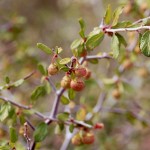Hog-plum, Texas Colubrina , Texas Snakewood
Colubrina texensis
Rhamnaceae (Buckthorn family)
Description
Hog-plum, in the Buckthorn family (Rhamnaceae), is a many-branched, 4 to 6 ft or 1 to 2 m tall shrub without spines. It tends to be thicket-forming with light gray bark and a grayish-green pallor. Another common name for it is Texas Snakewood as the branches tend to show a zig-zag pattern. Twigs are white-tomentose at first, losing their hair as they mature. The deciduous leaves are small (<2.5 cm), alternate, borne on stems, and somewhat oval. They are clustered at nodes and have toothed margins and prominent parallel venation. Densely hairy at first, later they become hairless. Small, greenish-yellow flowers are on short, twig-like shoots. They are 5-petaled and star-shaped in axillary clusters usually from late spring to early summer. The small, brownish fruit is a hard, three-celled, spherical capsule attached to a recurved, red pedicel. As the fruit matures, it goes from green to red, to dark brown or black. It is a drupe separated into two or three nutlets. Like the stems and leaves, the fruit is tomentose at first and matures to be hairless. It persists into the fall.Habitat
Hog-plum is found in gravelly arroyos and on rocky hillsides in southwestern Texas. It is very drought tolerant as well as being an aggressive invader of disturbed areas.Toxic Agent
The toxicity of this plant is questionable, and any potentially toxic agents are unidentified. The fruits and seeds are the plant parts of concern.Signs of Livestock Ingestion
Hog-plum is browsed by all species of livestock. Controlled experimentation has not been performed to establish its potential toxicity. Field reports indicate that sheep may have been poisoned after ingestion of fruits and seeds. The condition is similar to Lechuguilla poisoning, with clinical signs including: Photosensitization, swelling of the head and ears; Jaundice (yellow discoloration of mucous membranes, eyeballs, skin, fat); Death.Management Strategies
The plant is usually not a problem for livestock producers. Avoid placing sheep in pastures with heavy populations of Hog-plum when the plant is in fruit or seed stages and when other forage is not readily available. Observe livestock closely and remove animals from infested pastures at the first signs of poisoning.Images
Plant Characteristics
Flower Color: Yellow
Seed Type: Drupe, Fruit/Berry
Duration: Perennial
Stem Texture: Hairless/Smooth, Prickly, Spiny, or Thorny
Growth Habit: Shrub (Woody)
Leaf Shape
 : Simple with Pinnate or Parallel Venation
: Simple with Pinnate or Parallel Venation
Season: Warm
Distribution
 : 02 - Gulf Prairies and Marshes, 05 - Cross Timbers and Prairies, 06 - South Texas Plains, 07 - Edwards Plateau, 09 - High Plains, 10 - Trans-Pecos
: 02 - Gulf Prairies and Marshes, 05 - Cross Timbers and Prairies, 06 - South Texas Plains, 07 - Edwards Plateau, 09 - High Plains, 10 - Trans-Pecos
Distributions
Distribution refers to the ecological region in Texas that a plant has been found. You can also view a clickable map.
Book: Toxic Plants of Texas (B-6105)
Collection: Toxics
Livestock Affected: Sheep
Livestock Signs: Jaundice (yellowish mucous membranes), Photosensitization






